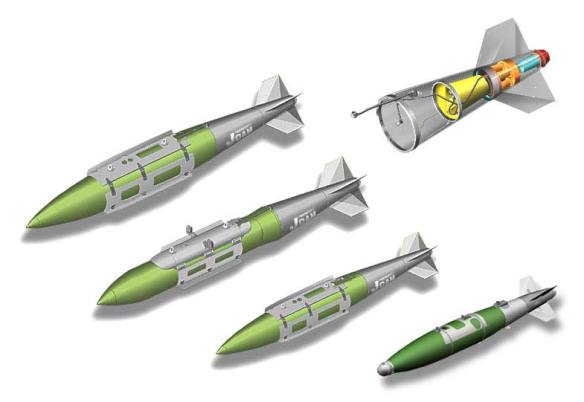
Small Diameter Bomb
Two highly accurate, all-weather, autonomous air-delivered weapons developed by the U. S. Air Force that utilize the precise timing signal of the Navigation Signal Timing and Ranging (NAVSTAR) Global Positioning System (GPS) satellites for all-weather precision attacks of ground targets. The Joint Direct Attack Munition (JDAM) is a tail kit that attaches to the rear of conventional 500-pound, 1,000-pound, or 2,000-pound gravity bombs. The carrying aircraft can launch the weapon up to 15 miles from the target and program each weapon it carries to strike separate targets. Once released, the bomb’s Inertial Navigation System (INS)/GPS guides the bomb to its target regardless of weather conditions. The weapon can impact within 5 yards of the target in the GPS-aided INS mode or within 10 yards in INS-only mode.
The U. S. Air Force began developing the JDAM in the late 1980s but shelved it in 1989. During the Persian Gulf War, however, the air force discovered that clouds and smoke adversely affected the accuracy of its laser-guided bombs. Chief of staff of the air force General Merrill A. McPeak subsequently directed the development of an all-weather, low-cost, and highly accurate air-delivered weapon. In 1995 McDonnell Douglas (now Boeing) began producing the JDAM tail kits at a cost of $18,000 each. Today, every strike aircraft in the U. S. Air Force, the U. S. Navy, and the U. S. Marine Corps and many strike aircraft of U. S. allies can carry the JDAM.
The JDAM, launched from the B-2 Spirit bomber, first saw combat during Operation allied force, the North Atlantic Treaty Organization (NATO) 1999 bombing campaign against the Federal Republic of Serbia. Flying nonstop from Whiteman Air Force Base, Missouri, the B-2s, equipped with 16 2,000-pound JDAMs, each delivered more than 650 JDAMs with 96 percent reliability and hit 87 percent of their intended targets during the campaign. The bombers could launch the JDAMs individually or in groups, each programmed to hit a separate target.
During Operation Enduring Freedom that began in October 2001, the JDAM quickly became the air-delivered weapon of choice to attack enemy forces in close proximity to friendly forces or civilian centers. Using laser range-finding binoculars and GPS receivers, special operations ground controllers with Northern Alliance forces identified targets and relayed the coordinates to the Air Operations Center in Kuwait or to aircraft over the battlefield.
The venerable Boeing B-52 Stratofortess and the 20-year-old Rockwell International B-1B Lancer, carrying up to 24 2,000- pound JDAMs each, loitered over the battlefield up to eight hours a day with air refueling, waiting for new targeting data, until they expended their ordnance. These strategic bombers had essentially become on-call aerial artillery. Many carrier-based aircraft took off without knowing the location of their targets, receiving this data only as they entered the combat zone.
After the Anglo-American-led invasion of Iraq in March 2003 and during the continuing combat in Afghanistan and in Iraq, U. S. and coalition aircraft continued to refine procedures to hit targets of opportunity with JDAMs in near real time. As combat operations continued, the war fighters in the Middle East identified the need for two additional capabilities: a JDAM capable of striking moving targets and a precise weapon with a smaller blast and fragmentation pattern than the 500-pound JDAM. By mid-2007 the Air Armament Center, Eglin Air Force Base, Florida, had developed the Laser JDAM with a laser seeker in the nose that tracks and hits a target moving up to 50 miles per hour and awarded the production contract to Boeing.
The U. S. Air Force began development of the Small Diameter Bomb (SDB) in 2003. It is only six feet long and weighs 285 pounds. It comes in two variants, one with GPS/INS guidance only and one with GPS/INS guidance and a laser seeker to hit moving targets. Its special bomb carriage system can carry four SDBs on one weapons station. The weapon can be launched up to 60 miles from the target. Because of its smaller size, strike aircraft can carry more individual weapons, giving the fliers increased kills per mission. It also provides reduced collateral damage in urban areas (such as those in Iraq) in which the military struggles at times to find a weapon with the desired kill effect but without excessive blast or fragmentation effects.
The U. S. Air Force declared the SDB operational in September 2006 with initial integration with the F-15E Strike Eagle with follow- on integration on other air force strike aircraft. Because of its capabilities, the SDB system is an important air-delivered weapon in the ongoing Global War on Terror.
References History Office. History of the Air Armament Center, 1 October 2006-30 September 2007. Eglin Air Force Base, FL: Air Armament Center, 2008. Lambeth, Benjamin S. Air Power against Terror: America’s Conduct of Operation Enduring Freedom. Santa Monica, CA: RAND Corporation, 2005. —. NATO’s Air War for Kosovo: A Strategic and Operational Assessment. Project Air Force Series on Operation Allied Force. Washington, DC: RAND Corporation, 2001.